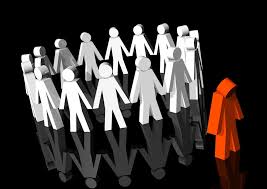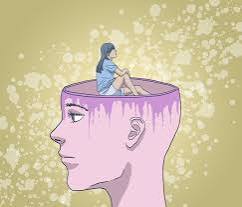Social isolation refers to a state of complete or near-complete lack of contact between an individual and society.
Social isolation differs from loneliness.
Loneliness reflects temporary and involuntary lack of contact with other humans in the world.
Social isolation can affect individuals of any age.
Types of social isolation can include staying home for lengthy periods of time, having no communication with family, acquaintances or friends, and/or willfully avoiding any contact with other humans when those opportunities do arise.
Chronic social isolation over years and decades can affect all aspects of a person’s existence, leading to feelings of loneliness, fear of others, or negative self-esteem.
Lack of consistent human contact can also cause conflict with friends, and family.
In a mood-related isolation, the individual may isolate during a depressive episode only to reappear when their mood improves.
Social isolation is a risk factor for and may contribute to impaired cognitive performance and poorer executive functioning, faster cognitive decline, more negative and depressive cognition, heightened sensitivity to social threats, and a self-protective confirmatory bias in social cognition.
Socially isolated individuals are at increased risk for the development of cardiovascular disease, infectious illness, cognitive deterioration, and mortality.
Social isolation contributes to accelerating the ageing process.
After controlling for social network size and frequency of social activity, perceived social isolation is predictive of cognitive decline and risk for Alzheimer’s disease.
Social interactions of individuals who feel socially isolated are more negative and less subjectively satisfying: contributing to more isolation.
Perceived social isolation is associated with increased resting-state functional connectivity between several nodes of the cingulo-opercular network, a neural network associated with tonic alertness.
Perceived social isolation is also associated with reduced resting-state functional connectivity between the cingulo-opercular network and the right superior frontal gyrus, suggesting diminished executive control.
Lonely individuals express weaker activation of the ventral striatum in response to pleasant pictures of people than of objects, suggesting decreased reward to social stimuli.
Lonely individuals express greater activation of the visual cortex in response to negative facial expressions rather than of objects.
Loneliness is negatively correlated with gray matter density in the left posterior temporal sulcus, an area involved in biological motion perception, mentalizing, and social perception.
Neuroimaging studies on perceived social isolation have emphasized implications of the visual cortex and right-hemispheric stress-related circuits underlying difference between lonely and non-lonely individuals.
The loneliness-linked neurobiological brain regions are known as the default mode network.
The loneliness-Linked neurological brain regions show increased grey matter volume than other cortical brain networks.
Lonely individuals display stronger functional communication in the default network, suggesting the up-regulation of these neural circuits supports mentalizing, reminiscence and imagination to fill the social void.
Social isolation contributes to abnormal hippocampal development, contributing to decreased expression of the synaptic protein synaptophysin, decreased dendritic length and dendritic spine density of pyramidal cells.
There are structural neuronal alterations and microtubule stabilizations, impairing remodeling and extension of axons and dendrites.
Perceived social isolation is associated with under-expression of genes bearing anti-inflammatory glucocorticoid response elements: and over-expression of genes bearing response elements for pro-inflammatory NF-κB transcription factors.
Social isolation in the lonely, is associated with decreased lymphocyte sensitivity to physiological regulation by the HPA axis.
These facts suggest increased activity of the HPA axis, and the development of glucocorticoid resistance in chronically lonely individuals.
Socially isolated individuals are more vulnerable to suicide than those who have strong social ties with others.
A lack of social relationships has a negatively impact on the development of the brain’s structure, as mental health issues of depression, anxiety, and suicide may be associated with social isolation.
The isolation of a member of a social species experimentally has detrimental biological effects.
Social isolation is a potential cause and a symptom of emotional or psychological challenges.
Certain risk factors contribute to reasons individuals distance themselves from society.
Domestic violence
Family crisis
Health and disabilities
Loss of a spouse
Unemployment
Aging
Hearing loss
Transportation problems
Societal adversity, the desire to avoid the discomfort, dangers, and responsibilities arising from being among people.
Missing special events
The rate of living alone for people under 45 has not changed, but the rate for Americans aged 45-65 has increased over the past 25 years.
People over the age of 65 live alone less often.
Social isolation due to unemployment has been seen to particularly affect men.
Social isolation can begin early in life,when a child becomes more preoccupied with feelings and thoughts of their individuality that are not easy to share with other individuals.
Social isolation in childhood can result from feelings of shame, guilt, or alienation during childhood experiences.
Individuals with learning impairments, are commonly socially isolated.
Substance abuse can also be an element in isolation.
Living alone can increase rates of being socially isolated and lead individuals to the use of alcohol and other substances.
The loss of a loved one can contribute to social isolation:
Widows who have a lot of social contact and interactions lead to fewer depressive symptoms.
Social isolation is not beneficial to an individual’s mental health during a time of loss.
Increased social media support is not equal to increased immediate social support in terms of combating depressive and anxious symptoms, thus supporting the value of quality of engaging in person social interaction over virtual social interaction.
Social isolation affects 24% of older adults in the United States, approximately 9 million people.
The elderly have a unique dynamics that often drive the individual into deeper isolation: frailty, declines in overall health, absent or uninvolved relatives or children, and economic struggles can all add to the feeling of isolation.
In the older population childlessness can be a cause for social isolation.
Retirement, the death of close friends or spouses can also contribute to social isolation in the elderly.
Nearly half of all members of senior communities are at high risk for social isolation
Social isolation is especially prevalent with seniors of a lower education, lower economic class and compounded by diminished availability of socializing options.
Among the elderly social isolation has been linked to an increase in disease morbidity, a higher risk of dementia, and a decrease in physical mobility along with an increase in general health concerns.
Increased cognitive decline has been link to an increase in social isolation in depressed elderly women.
Hearing loss contributes to social isolation among elderly individuals.
The risk of hearing loss increases with age due to the non-regenerative nature of the hair cells in the ear responsible for hearing.
Hearing loss, especially in older adults, is associated with the inability to effectively communicate, which can lead to social isolation.
Hearing loss makes maintaining interpersonal relationships difficult , which can result in social isolation.
Hearing loss and loneliness associations: A Dutch study demonstrated a seven percent increase in odds of developing loneliness for each one decibel drop in sound perception in adults under 70 years old.
Social isolation and loneliness in older adults is associated with an increased risk for poor mental and physical health and increased mortality.
Early mortality increases risk in individuals experiencing social isolation compared to those who are not socially isolated.
Social isolation is associated with increased risk of: high blood pressure, high cholesterol, elevated stress hormones, and weakened immune systems.
Social isolation and mortality in the elderly share a common link to chronic inflammation.
It is associated with poor mental health including increased risk for depression, cognitive decline, depression,anxiety, and substance use.
Prevention of loneliness in childhood may be a protective factor against depression in adulthood.
Socially isolated children tend to have lower subsequent educational attainment, be part of a less advantaged social class in adulthood, and are more likely to be psychologically distressed in adulthood.
Social assistance studies show that children can cope more easily with high levels of stress.


